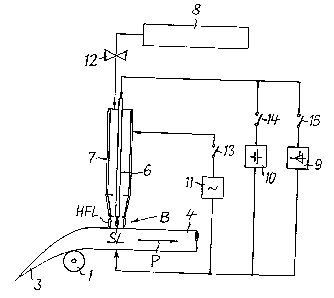Some of the information on this Web page has been provided by external sources. The Government of Canada is not responsible for the accuracy, reliability or currency of the information supplied by external sources. Users wishing to rely upon this information should consult directly with the source of the information. Content provided by external sources is not subject to official languages, privacy and accessibility requirements.
Any discrepancies in the text and image of the Claims and Abstract are due to differing posting times. Text of the Claims and Abstract are posted:
| (12) Patent: | (11) CA 2180796 |
|---|---|
| (54) English Title: | METHOD OF IGNITING A WELDING ARC |
| (54) French Title: | METHODE D'ALLUMAGE D'UN ARC DE SOUDAGE |
| Status: | Expired and beyond the Period of Reversal |
| (51) International Patent Classification (IPC): |
|
|---|---|
| (72) Inventors : |
|
| (73) Owners : |
|
| (71) Applicants : |
|
| (74) Agent: | SMART & BIGGAR LP |
| (74) Associate agent: | |
| (45) Issued: | 2004-09-14 |
| (22) Filed Date: | 1996-07-09 |
| (41) Open to Public Inspection: | 1997-01-12 |
| Examination requested: | 2003-03-05 |
| Availability of licence: | N/A |
| Dedicated to the Public: | N/A |
| (25) Language of filing: | English |
| Patent Cooperation Treaty (PCT): | No |
|---|
| (30) Application Priority Data: | ||||||
|---|---|---|---|---|---|---|
|
A method is indicated for igniting a welding arc
between a fixed electrode and a metal workpiece to be
welded, whereby a covering protective gas is supplied by
a nozzle that extends into the welding area. Before a
welding power source is switched on for the welding arc,
an auxiliary arc supplied by an auxiliary power source is
ignited, which ignites the welding arc after the welding
power source is switched on. To better ionize the
welding area and ensure the ignition of the auxiliary
welding arc, a high-frequency electric arc is produced in
the welding area between the nozzle and the workpiece by
means of a pulse generator which produces high-frequency
high-voltage pulses.
Note: Claims are shown in the official language in which they were submitted.
Note: Descriptions are shown in the official language in which they were submitted.

2024-08-01:As part of the Next Generation Patents (NGP) transition, the Canadian Patents Database (CPD) now contains a more detailed Event History, which replicates the Event Log of our new back-office solution.
Please note that "Inactive:" events refers to events no longer in use in our new back-office solution.
For a clearer understanding of the status of the application/patent presented on this page, the site Disclaimer , as well as the definitions for Patent , Event History , Maintenance Fee and Payment History should be consulted.
| Description | Date |
|---|---|
| Time Limit for Reversal Expired | 2012-07-09 |
| Letter Sent | 2011-07-11 |
| Grant by Issuance | 2004-09-14 |
| Inactive: Cover page published | 2004-09-13 |
| Inactive: Final fee received | 2004-06-25 |
| Pre-grant | 2004-06-25 |
| Notice of Allowance is Issued | 2004-05-21 |
| Notice of Allowance is Issued | 2004-05-21 |
| Letter Sent | 2004-05-21 |
| Inactive: Approved for allowance (AFA) | 2004-05-03 |
| Amendment Received - Voluntary Amendment | 2004-04-13 |
| Inactive: S.30(2) Rules - Examiner requisition | 2004-02-02 |
| Letter Sent | 2003-03-13 |
| Inactive: Status info is complete as of Log entry date | 2003-03-13 |
| Inactive: Application prosecuted on TS as of Log entry date | 2003-03-13 |
| Request for Examination Requirements Determined Compliant | 2003-03-05 |
| All Requirements for Examination Determined Compliant | 2003-03-05 |
| Application Published (Open to Public Inspection) | 1997-01-12 |
There is no abandonment history.
The last payment was received on 2004-06-03
Note : If the full payment has not been received on or before the date indicated, a further fee may be required which may be one of the following
Please refer to the CIPO Patent Fees web page to see all current fee amounts.
| Fee Type | Anniversary Year | Due Date | Paid Date |
|---|---|---|---|
| MF (application, 2nd anniv.) - standard | 02 | 1998-07-09 | 1998-06-23 |
| MF (application, 3rd anniv.) - standard | 03 | 1999-07-09 | 1999-06-15 |
| MF (application, 4th anniv.) - standard | 04 | 2000-07-10 | 2000-06-21 |
| MF (application, 5th anniv.) - standard | 05 | 2001-07-09 | 2001-06-14 |
| MF (application, 6th anniv.) - standard | 06 | 2002-07-09 | 2002-06-13 |
| Request for examination - standard | 2003-03-05 | ||
| MF (application, 7th anniv.) - standard | 07 | 2003-07-09 | 2003-06-03 |
| MF (application, 8th anniv.) - standard | 08 | 2004-07-09 | 2004-06-03 |
| Final fee - standard | 2004-06-25 | ||
| MF (patent, 9th anniv.) - standard | 2005-07-11 | 2005-06-07 | |
| MF (patent, 10th anniv.) - standard | 2006-07-10 | 2006-06-28 | |
| MF (patent, 11th anniv.) - standard | 2007-07-09 | 2007-06-26 | |
| MF (patent, 12th anniv.) - standard | 2008-07-09 | 2008-06-20 | |
| MF (patent, 13th anniv.) - standard | 2009-07-09 | 2009-06-25 | |
| MF (patent, 14th anniv.) - standard | 2010-07-09 | 2010-06-25 |
Note: Records showing the ownership history in alphabetical order.
| Current Owners on Record |
|---|
| ALCATEL KABEL AG & CO |
| Past Owners on Record |
|---|
| GUNTER TITZE |
| WOLFRAM KLEBL |